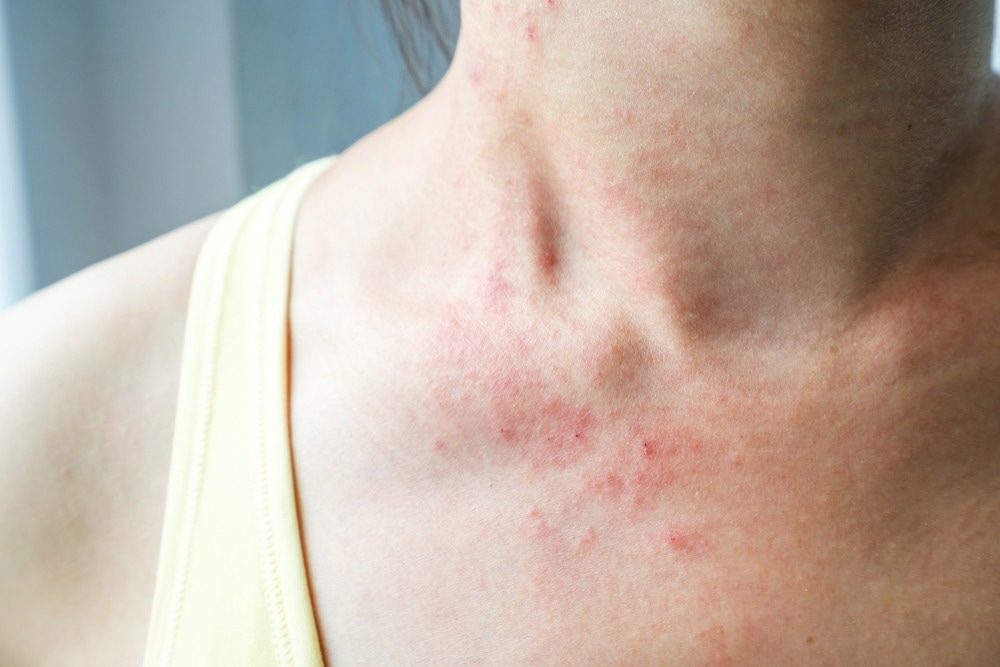Although initially, coronavirus disease 2019 (COVID-19) infections were found to mostly affect the lower and upper airways along with the lungs, several extrapulmonary manifestations involving the kidney, intestine, skin, brain, heart, liver, and placenta have been reported thereafter.
 Study: SARS-CoV-2 and Skin: New Insights and Perspectives. Image Credit: kitzcorner/Shutterstock
Study: SARS-CoV-2 and Skin: New Insights and Perspectives. Image Credit: kitzcorner/Shutterstock
Background
Regarding skin, various eruption patterns affect both children and adults worldwide. Some common cutaneous manifestations associated with COVID-19 were erythematous rashes, livedoid lesions, acro-ischemia, pseudo-chilblains, or cutaneous manifestations resembling erythema elevatum diutinum, pityriasis rosea, Grover disease, and erythema multiforme.
Angiotensin-converting enzyme (ACE2) is a transmembrane protein enzyme that plays an integral role in the renin-angiotensin-aldosterone system (RAAS). Angiotensin I, which is obtained from the liver, is converted by ACE to angiotensin II, which is further cleaved to angiotensin 1–7 and finally helps in inflammation and vasodilation.
ACE2 is important in mediating severe acute respiratory syndrome coronavirus 2 (SARS-CoV-2) infection. ACE2 binds to the receptor-binding domain (RBD) of the S1 SARS-CoV-2 protein, while S2 carries out the fusion of the host and viral cell membrane. This is followed by the expression of transmembrane serine protease 2 (TMPRSS2) and transcription of viral proteins that generates multiple virions and helps spread disease. Expression of ACE2 has been reported in various parts of the body. However, studies on their expression at the skin level are relatively low.
A new study published in Biomolecules analyzed the possibility of penetration of SARS-CoV-2 into the skin. It also studied the expression of TMPRSS2 as well as carried out a review of the current literature to determine pathways that related ACE-2 expression to SARS-CoV-2 outcomes.
About the study
The study involved the collection of skin biopsy samples from SARS-CoV-2 positive patients as well as controls between 16th May 2020 and 11th May 2021. All clinical data, along with COVID-19 severity, was also collected from the patients. The symptoms were considered mild, including cough, fever, headache, malaise, altered taste, and myalgia. Symptoms were considered moderate if there was evidence of pneumonia and/or oxygen saturation (SaO2) was equal to or greater than 94%. Symptoms were considered severe if the SaO2 was less than 94% or there were symptoms of respiratory failure.
The expression of TMPRSS2 and ACE2 was determined using anti-ACE2 and anti-TMPRSS2 monoclonal antibodies and immunohistochemistry scores where a chromogen signal was highlighted in the cell membrane and/or cytoplasm. Different scores were assigned based on the degree of staining intensity.
The literature review was carried out using the Web of Sciences (WoS) and PubMed with the help of specific keywords such as COVID, Coronavirus, skin, rash with ACE2, and RAAS. Only those articles that were published in English were selected. The extraction of data was carried out by two investigators. All the selected articles were assessed using the Oxford Centre for Evidence-Based Medicine 2011 guidelines.
Study findings
The results indicated a strong S1 glycoprotein positivity at the excretory portion of the eccrine sweat glands as well as the endothelium of small blood vessels. Moreover, the expression of SARS-CoV-2 was found to be greater in keratinocytes, while a significant signal was also found at the adenomeres of the eccrine sweat glands. Expression of ACE2 mRNA was also observed in the skin tissues. However, the majority of keratinocytes were found to be negative forTMPRSS2.
A total of 33 publications were included in the literature review. Most of them comprised reviews followed by original articles and case series. Additionally, all the included studies were rated as level 4 or 5 in the Oxford Center for Evidence-Based Medicine 2011 guidelines for clinical research.
Therefore, the current study demonstrated that SARS-CoV-2 was directly able to cause infection through the eccrine sweat glands. However, several authors do not align with the findings of this study. Moreover, this study could not confirm whether COVID-19 is capable of causing dermatological symptoms. Further studies using larger populations are required to determine this aspect of the pandemic accurately.
Limitations
One prominent limitation of the current study is that although the immuno-expression of TMPRS22 and ACE2 could explain the direct penetration of the virus, it cannot explain the basis of SARS-CoV-2 rashes.